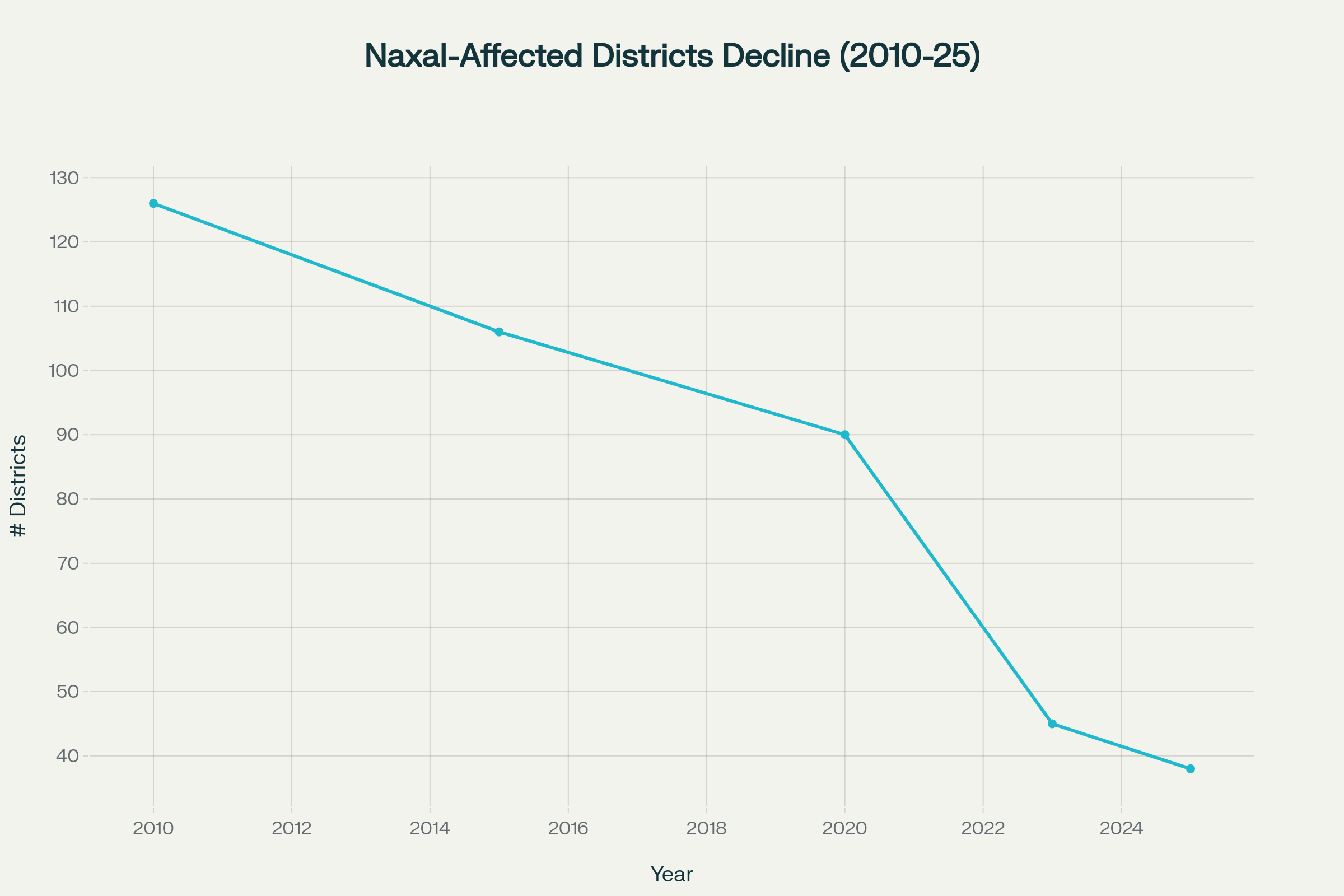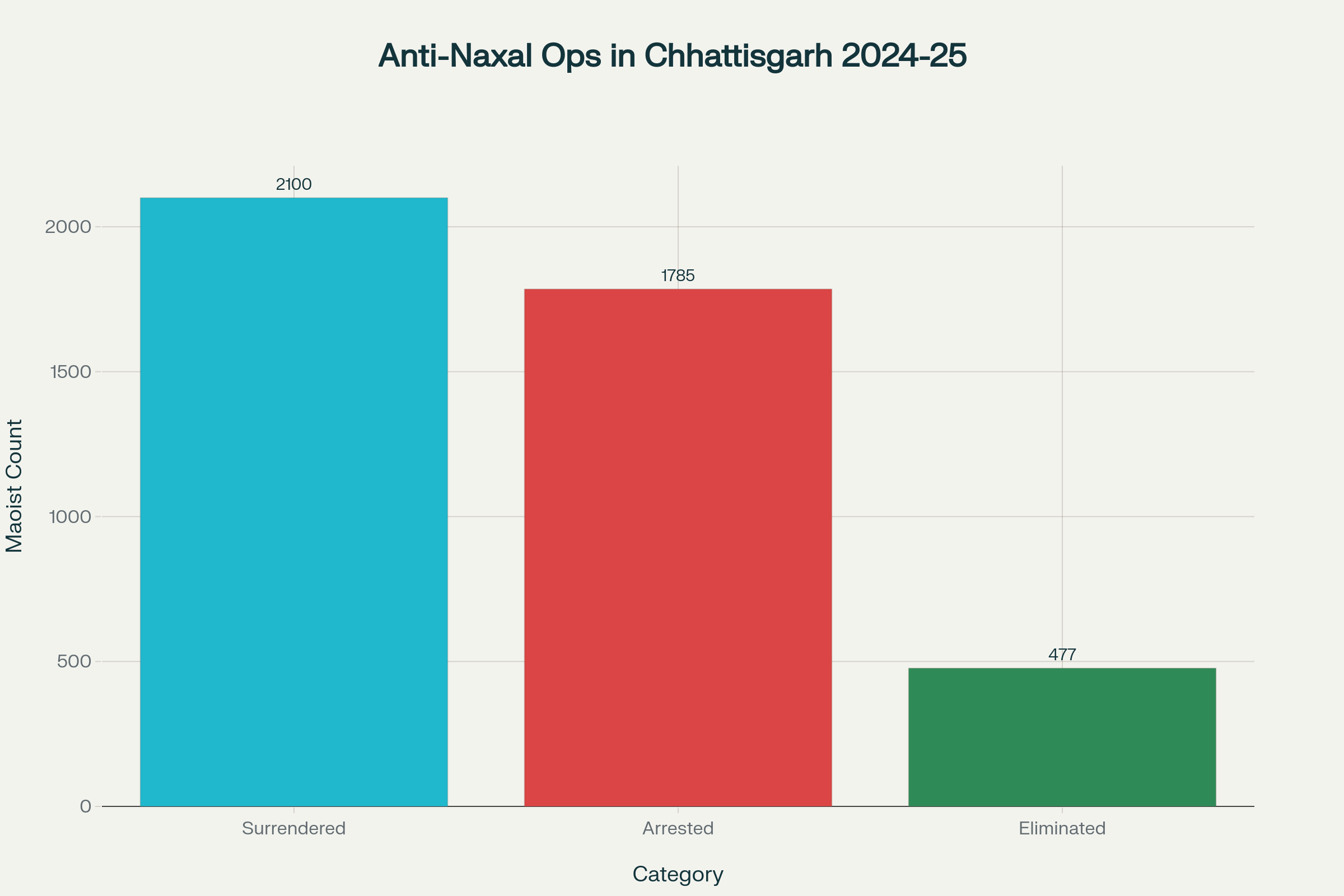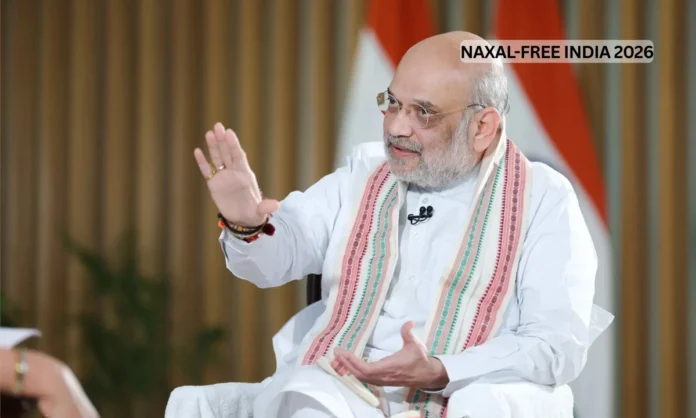Key Highlights:
- 258 Maoists surrendered in just two days across Chhattisgarh and Maharashtra, accelerating progress toward Naxal-free India
- Abujhmarh and North Bastar regions officially declared Naxal-free by Home Minister Amit Shah
- Government maintains firm March 31, 2026 deadline for complete Naxal-free India achievement
Union Home Minister Amit Shah announced an unprecedented milestone in India’s journey toward a Naxal-free India as 258 battle-hardened Maoists surrendered across Chhattisgarh and Maharashtra within just two days. This historic development reinforces Shah’s unwavering commitment to achieving a Naxal-free India by March 31, 2026, marking the most significant breakthrough in the government’s comprehensive strategy against Left Wing Extremism.
लाल आतंक पर सुशासन, विकास और विश्वास की ऐतिहासिक जीत!
— Arun Sao (@ArunSao3) October 17, 2025
छत्तीसगढ़ अब एक नए युग की दहलीज पर खड़ा है, जहां नक्सलवाद का अंधकार पीछे छूट रहा है और विकास, विश्वास और शांति की किरणें हर कोने में फैल रही हैं।
यह संभव हो पाया है आदरणीय प्रधानमंत्री श्री नरेंद्र मोदी जी के सशक्त नेतृत्व,… pic.twitter.com/1jau2jOcFE
The mass surrender represents the largest capitulation in India’s decades-long battle against Maoism, with 170 cadres laying down arms in Chhattisgarh on Thursday alone, following 27 surrenders the previous day in the same state and 61 in Maharashtra. Shah declared that two of the most terror-affected regions, Abujhmarh and North Bastar in Chhattisgarh, are now completely free from Maoist influence, bringing the nation significantly closer to the vision of a Naxal-free India.government.
Historic Mass Surrender Accelerates Naxal-Free India Timeline
The recent wave of Maoist surrenders demonstrates the effectiveness of the Modi government’s multi-pronged strategy for achieving a Naxal-free India. Among those who surrendered was Satish alias T Vasudeo Rao, carrying a reward of ₹1 crore on his head, along with other senior operatives including Ranita (SZCM, Secretary of Maad DVC) and Bhaskar (DVCM, PL 32), representing a significant blow to the extremist organization’s command structure and accelerating the path to a Naxal-free India.
This surrender follows a remarkable trend supporting the mission for a Naxal-free India, with the cumulative impact being felt across affected regions. The dramatic escalation in capitulations reflects the mounting pressure from coordinated security operations and the government’s rehabilitation policies that welcome those who abandon violence in favor of a Naxal-free India.
- The surrender includes high-ranking commanders and area committee members with extensive operational experience
- Over three dozen advanced weapons were handed over, significantly weakening Maoist capabilities
- Strategic locations previously considered impregnable have been successfully cleared of extremist presences
Shah emphasized the government’s dual approach toward achieving a Naxal-free India, stating that those choosing to surrender would be welcomed into mainstream society while those continuing armed resistance would face the full force of security operations. This balanced strategy has proven instrumental in encouraging voluntary surrenders while maintaining pressure on remaining extremist elements blocking the path to a Naxal-free India.

Dramatic decline in Naxal-affected districts shows India’s progress toward complete elimination of Left Wing Extremism by 2026
Territorial Gains Demonstrate Progress Toward Naxal-Free India
The government’s systematic approach has yielded substantial territorial gains in the mission for a Naxal-free India, with the number of Left Wing Extremism-affected districts dramatically reduced from 126 in 2013 to just 18 currently, with only 6 classified as ‘Most Affected Districts’. According to official Ministry of Home Affairs data, this represents unprecedented progress toward a Naxal-free India.
The government has further achieved a historic milestone by reducing the most affected districts from 6 to just 3, with only Bijapur, Sukma, and Narayanpur in Chhattisgarh remaining in this category. This dramatic reduction demonstrates the effectiveness of the comprehensive strategy for establishing a Naxal free India.
| Year | Most Affected Districts | Total LWE Districts | Progress toward Naxal-free India |
|---|---|---|---|
| 2013 | Data not specified | 126 | Initial baseline |
| 2020 | Data not specified | 90 | Significant progress |
| 2024 | 6 | 18 | Major breakthrough |
| 2025 | 3 | 11 | Near completion |
Statistical analysis reveals the comprehensive nature of anti-Naxalism operations since the BJP government took control of Chhattisgarh in January 2024, directly supporting the Naxal free India objective. Shah reported that 2,100 Naxalites have surrendered, 1,785 have been arrested, and 477 have been eliminated through security operations. These figures underscore the accelerated pace of operations as the March 2026 Naxal-free India deadline approaches.
- Violence-related incidents have decreased dramatically across all affected regions
- Operational successes in 2024 included elimination of 312 LWE cadres, including CPI (Maoist) General Secretary
- 836 LWE cadres arrested and 1,639 surrendered during the year, including Polit Bureau and Central Committee members
The territorial consolidation extends beyond mere numbers in the quest for a Naxal-free India, with previously inaccessible regions now under government control. Abujhmarh, once considered the heart of Maoist operations, has been completely cleared, allowing development initiatives to commence in areas that remained cut off from mainstream India for decades.government.
Comprehensive Policy Framework Supporting Naxal-Free India Vision
The government’s strategy for achieving a Naxal-free India operates through the National Action Plan and Policy to address Left Wing Extremism, which encompasses security measures, development interventions, and community rights protection. The multi-pronged approach includes precise intelligence-based and people-friendly counter Left Wing Extremism operations, supporting the broader vision of a Naxal-free India.
The comprehensive strategy supporting a Naxal-free India includes swift domination of areas with security vacuum, targeting of top leaders as well as over ground workers, countering the nefarious ideology, rapid development of infrastructure and saturation of welfare schemes. Additional components include choking of finances, enhanced coordination between states and centre governments, and accelerated investigation and prosecution of Maoist related cases.

Comprehensive anti-Naxalism operations in Chhattisgarh show multi-pronged approach to achieving Naxal free India goal
- Precise intelligence-based operations have eliminated key leadership structures
- People-friendly counter-operations have gained community support in affected areas
- Infrastructure development programs address root causes of alienation
The policy recognizes that sustainable peace and a lasting Naxal-free India requires addressing root causes of alienation through development and governance improvements. The comprehensive approach ensures that cleared areas remain permanently free from extremist influence, contributing to the permanence of a Naxal-free India.
Strategic Timeline for Achieving Naxal-Free India by 2026
Home Minister Shah’s March 31, 2026 deadline for a Naxal-free India represents a concrete commitment backed by operational milestones and resource allocation. The timeline reflects the government’s confidence in dismantling the remaining Maoist infrastructure and achieving complete territorial control in support of a Naxal free India.
Current assessments indicate that South Bastar remains the primary area requiring intensive operations before achieving a complete Naxal free India, with security forces expecting additional high-level surrenders in the coming months. The government’s confidence in meeting the 2026 Naxal-free India deadline stems from the accelerating pace of surrenders and the systematic degradation of Maoist command structures.government.
- Intelligence agencies report increasing disillusionment within remaining Maoist ranks
- Development projects in cleared areas demonstrate long-term commitment to transformation
- Coordinated operations between states and centre ensure comprehensive coverage
The strategic approach recognizes that achieving a complete Naxal-free India requires not just military success but also ensuring that cleared areas remain permanently free from extremist influence through sustained development initiatives. This comprehensive vision extends beyond the immediate 2026 Naxal-free India target to establish lasting peace and prosperity in formerly affected regions.
Final Perspective on India’s Path to Complete Naxal Elimination
The unprecedented surrender of 258 Maoists within 48 hours marks a decisive turning point in India’s mission toward a Naxal free India, validating the Modi government’s comprehensive strategy combining security operations with development initiatives. Home Minister Amit Shah’s declaration of Abujhmarh and North Bastar as Naxal-free territories demonstrates tangible progress toward the ambitious March 2026 Naxal-free India deadline.government.
The systematic reduction of most affected districts from 6 to 3, coupled with the surrender of high-ranking commanders carrying substantial bounties, indicates that the vision of a Naxal free India is rapidly approaching reality. With only South Bastar remaining as a significant stronghold, the comprehensive strategy has proven both effective and sustainable in progressing toward a Naxal free India.
The government’s balanced approach of welcoming surrenders while maintaining operational pressure has created conditions conducive to achieving a complete Naxal-free India by March 2026. As the final phase of operations commences, the combination of territorial gains, leadership elimination, and mass surrenders provides strong foundations for establishing and maintaining a permanent Naxal-free India across all affected regions.


